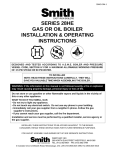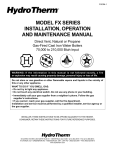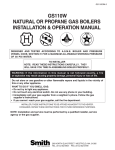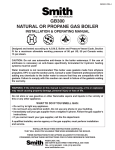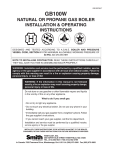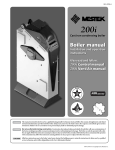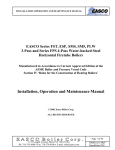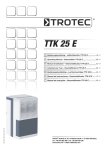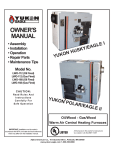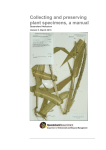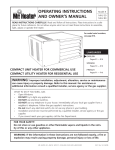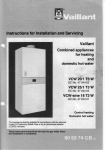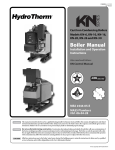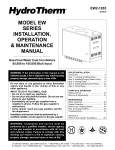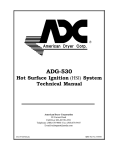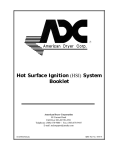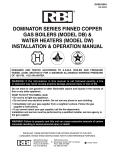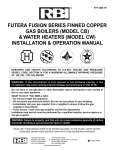Download Smith Cast Iron Boilers GVIOM-5R User's Manual
Transcript
GVIOM-5R GV100W NATURAL OR PROPANE GAS BOILER INSTALLATION & OPERATING INSTRUCTIONS DESIGNED AND TESTED ACCORDING TO A.S.M.E. BOILER AND PRESSURE VESSEL CODE, SECTION IV FOR MAXIMUM ALLOWABLE WORKING PRESSURE OF 50 PSI, 345 kPa WATER NOTE TO INSTALLING CONTRACTOR: READ THESE INSTRUCTIONS CAREFULLY. THEY WILL SAVE YOU TIME IN ASSEMBLING BOILER PROPERLY. WARNING: Installation and service must be performed by a qualified installer, service agency or the gas supplier in accordance with all local and national codes. Failure to comply with this warning can result in a fire or explosion causing property damage, personal injury or loss of life! WARNING: If the information in this manual is not followed exactly, a fire or explosion may result causing property damge, personal injury or loss of life. Do not store or use gasoline or other flammable vapors and liquids in the vicinity of this or any other appliance. What to do if you smell gas: • Do not try to light any appliance. • Do not touch any electrical switch. Do not use any phone in your building. • Immediately call your gas supplier from a neighbor's phone. Follow the gas supplier's instructions. • If you cannot reach your gas supplier, call the fire department. Installation and service must be performed by a qualified installer, service agency or the gas supplier. INSTALLER, THESE INSTRUCTIONS TO BE AFFIXED ADJACENT TO THE BOILER. CONSUMER, RETAIN THESE INSTRUCTIONS FOR FUTURE REFERENCE PURPOSES. WESTCAST, INC. 260 NORTH ELM STREET WESTFIELD, MA 01085 TEL. (413) 562-9631 FAX (413) 562-3799 In Canada: 5211 Creekbank Road, Mississauga, Ont. L4W 1R3 (905) 625-2991 Fax (905) 625-6610 Page 2 GV100W BOILER INSTALLATION & OPERATING INSTRUCTIONS AVERTISSMENT. Assurez-vous de bien suivre les instructions données dans cette notice pour réduire au minimum le risque d’incendie ou d’explosion ou pour éviter tout dommoge matériel, toute blessure ou la mort Ne pas entreposer ni utiliser d’essence ou ni d’autres vapeurs ou liquides inflammables à proximité de cet appareil ou de tout autre appareil. QUE FAIRE SI VOUS SENTEZ UNE ODEUR DE GAZ: • Ne pas tenter d’allumer d’appareil. • Ne touchez à aucun interrupteur; ne pas vous servir des téléphones se trouvant dans le bâtiment. • Appelez immédiatement votre fournisseur de gas depuis un voisin. Suivez les intructions du fournisseur. • Si vous ne purvez rejoindre le fournisseur, appelez le service des incendies. L’installation et l’entretien doivent être assurés par un installateur ou un service d’entretien qualifié ou par le fournisseur de gaz. Table of Contents Before You Start .................................................. 2 Boiler Ratings & Capacities ................................. 3 Boiler Location .................................................... 3 Combustible Floor Option.................................... 4 Dimensions & Component Location .................... 5 Combustion Air .................................................... 6 Common Vent Systems ....................................... 6 Chimney & Vent Pipe Connection ....................... 7 Heating System Piping ........................................ 9 Gas Supply Piping ............................................. 12 Electrical Wiring ................................................ 13 Lighting Instructions .......................................... 17 BEFORE YOU START WARNING : This manual must be read and fully understood before installing, operating or servicing this boiler! Failure to follow these instructions could result in a fire or explosion causing extensive property damage, personal injury or death! These instructions cover the GV100W gas fired, induced draft low pressure, sectional, cast iron hot water boiler. GV100W boilers have been design certified by CSA for use with natural and propane gas under the latest edition of ANSI-Z21.13, GasFired Low-Pressure Steam and Hot Water Boilers and CGA 4.9, Gas-Fired Steam and Hot Water Boilers. Each unit has been constructed and hydrostatically tested for a maximum working pressure of 50 psi, 345 kPa in accordance with the A.S.M.E. Boiler and Pressure Vessel Code, Section IV for cast iron boilers. Each boiler has been equipped with a 30 psi pressure relief valve. This manual covers the application, installation, operation and maintenance of a GV100W low pressure hot water boiler. Boiler Operation ................................................ 19 Checking & Adjusting ........................................ 20 Boiler Maintenance ........................................... 21 Instructions to the Installer ................................ 22 Replacement Parts ............................................ 23 Health Warnings ................................................ 24 To obtain the safe, dependable, efficient operation and long life for which this boiler was designed, these instructions must be read, understood and followed. Direct all questions to your Smith Cast Iron Boiler distributor or write to the Customer Service Department, 260 North Elm Street, Westfield, MA 01085. Always include the model and serial numbers from the rating plate of the boiler in question. Page 3 GV100W BOILER INSTALLATION & OPERATING INSTRUCTIONS The owner should maintain a record of all service work performed with the date and a description of the work done. Include the name of the service organization for future reference. Where required by the authority having jurisdiction, the installation must conform to the Standard for Controls and Safety Devices for Automatically Fired Boilers, ANSI/ASME CSD-1. The installation must conform to the requirements of the authority having jurisdiction or, in the absence of such requirements, to the National Fuel Gas Code, ANSI Z223.1latest edition. In Canada, the installation must be in accordance with the requirements of CAN/CGA B149 Installation Code for Gas Burning Appliances and Equipment. 3. Ensure that the floor is structurally sound and will support the weight of the boiler. This boiler is designed for noncombustible floors only! A special base supplied by Smith Cast Iron Boilers must be used if the boiler is to be installed on a combustible floor. Never install this boiler on carpeting! 4. Do not install this boiler in a location that would subject any of the gas ignition components to direct contact with water or excessive moisture during operation or servicing. CAUTION: Do not install this boiler in a location subject to negative pressures or improper operation will occur. 5. Do not place this boiler in a location that would restrict the introduction of combustion air into the boiler. NEVER store objects on or around the boiler. BOILER RATINGS & CAPACITIES Before undertaking the installation of the GV100W check the boiler rating plate to ensure that the boiler is the proper size for the job. The “Net I=B=R Ratings” specify the equivalent amount of direct cast iron radiation that the boiler can handle under normal conditions. Also ensure that the boiler has been set up for the type of gas available at the installation site. Other important considerations are the availability of an adequate electrical supply, fresh air for combustion and a suitable chimney or vent system location. BOILER LOCATION WARNING: This boiler is for installation on noncombustible floors only! A special base supplied by the manufacturer must be used to install this boiler on a combustible floor. Failure to comply with this wwwwarning could result in property damage, severe personal injury or death! 1. Locate the boiler in an area that provides good access to the unit. Keep in mind that servicing may require the removal of jacket panels. Accessibility clearances must take precedence over fire protection clearances. 2. An optimum site will be level, central to the hot water piping system, close to a chimney or outside wall and have adequate fresh air for combustion. WARNING: Never store combustible materials, gasoline or any product containing flammable vapors or liquids in the vicinity of the boiler. Failure to comply with this warning can result in extensive property damage, severe personal injury or death! 6. If the boiler is to be located in an alcove, closet or other confined space the distances from the boiler and it’s vent system to all combustible construction must be equal to or greater than the minimum clearances in Figure 1. When installed in a closet or confined space two permanent openings of equal area adjoining another room or rooms having sufficient volume to meet the requirements of an unconfined space must be provided. Each opening must have a minimum free area of one square inch per 1000 Btu/hr, 2200 mm2/kW based on the total input rating of all gas utilization equipment in the confined area. Each opening must be no less than 100 in2, 64516 mm2, in size. The upper opening must be within 12 in, 305 mm, of, but not less than 3 in, 76 mm, from the top of the enclosure. The bottom opening must be within 12 in, 305 mm, of, but not less than 3 in, 76 mm, from the bottom of the enclosure. WARNING: Never install a PGV100W, propane boiler in a closet or other confined or enclosed space! Failure to comply with this warning could result in a fire or explosion causing extensive property damage, severe personal injury or death! Page 4 GV100W BOILER INSTALLATION & OPERATING INSTRUCTIONS COMBUSTIBLE FLOOR OPTION The GV100W boiler has been designed for use on noncombustible floors only. If a GV100W boiler is to be installed on combustible flooring of any type, it MUST be installed using the special base designed by the Smith Cast Iron Boiler Co. Never use a substitute base when installing this boiler on a combustible floor! WARNING: Never install a GV100W boiler on combustible flooring without using the special base specifically designed for it by the Smith Cast Iron Boiler Co. Do not alter in any way, the special base supplied by the Smith Cast Iron Boiler Co. Failure to comply with this warning may result in a fire causing extensive property damage, severe personal injury or death! To order the special base contact the nearest Smith Cast Iron Boiler distributor and ask for Smith’s Special Base, Part No. CB100-(sections). The number of sections is part of the model number recorded on the rating plate. If the model number is GV100W-7, the “-7” specifies that the boiler has seven sections. Therefore, the proper special base would be Part No. CB100-7. If the model number has a -3 order special base Part No. CB100-3, etc. If the GV100W is being installed in an alcove or closet ensure that the distances between the boiler and all combustible construction are greater than or equal to the minimum distances listed in FIG. NO. 1. CAUTION: Take care not to damage the burners, pilot or any other gas train components during this procedure. If a component is damaged, it must be replaced! Determine the best boiler location by following the instructions in the BOILER LOCATION section of this manual. Remove the front access panel and position the boiler in front of this location leaving room behind the boiler to work. Tightly thread a 1 1/4" elbow onto the close nipple in the supply pipe so the opening faces the front of the boiler. Thread a 4' length of 11/4" pipe into the elbow and carefully lift the front of the boiler. Slide a 3" thick brick or block under the first 1" of each boiler base side panel. Make sure the boiler is steady and won’t shift to the side. Remove the 4' length of pipe. Rotate the 1 1/4" elbow so it’s opening faces the back of the boiler. Thread the 4' length of pipe, or a shorter one if necessary, back into the elbow. Place the special base behind the boiler. Using extreme care lift the boiler up and slide the special base under the boiler. CAUTION: Never lift the boiler by the jacket panels or damage to the boiler may result! Make sure that the special base support channels are squarely under the boiler base side panels. Carfully slide the boiler and base into position. Center the boiler from side to side and ensure that the back of the burner base side panels are flush with the back of the Special Base support channels. Install the front grill supplied with the Special Base. Complete the boiler installation in accordance with the instructions set forth in this manual. Page 5 GV100W BOILER INSTALLATION & OPERATING INSTRUCTIONS FIG. NO. 1 Minimum Clearances to Combustible Construction C Clearances A B C D E F in mm 25 635 * * 6 4 7 4 152 102 178 102 in mm 25 635 2 51 6 4 7 4 152 102 178 102 To Service in mm N/A N/A A Alcove C Closet E F N/A 6 4 10 10 N/A 157 102 254 254 D B * No front wall for alcoves. FIG. NO. 2 Boiler Dimensions & Component Locations 2 11/16" B 8 5/8" 2 11/16" 6 1/2" 18" (1)PRESS. SWITCH (1)INDUCER (1) TEMP. CONTROL (2) 30" GAS INLET (1) (1) (2) JUNCTION BOX, CONTROL CENTER & INDUCER RELAY 13 1/4" (2) 6 3/4" (1) GAS (2) 13 1/2" 27 5/8" FLAME ROLL-OUT SWITCH VALVE 5 5/8" 11 1/2" A FRONT VIEW SIDE VIEW Notes: 1. Components located behind front panel 2. Vertical dimensions must be adjusted when using a base pan or concrete foundation under the boiler TABLE 1 Boiler Dimensions Boiler Size (# Sections) Dimension A Dimension B Vent Dia. Vent Dia. CATEGORY I CATEGORY III Single Wall Galv. in mm Horizontal Vent in mm in mm in mm 3 107⁄8 276 27⁄16 62 4 102 4 102 4 13 ⁄ 346 3 ⁄ 97 4 102 4 102 5 38 16 ⁄ 416 3 16 5⁄ 132 4 102 4 102 6 191⁄8 486 69⁄16 167 5 127 4 102 7 217⁄8 556 715⁄16 202 5 127 4 102 58 13 16 Page 6 GV100W BOILER INSTALLATION & OPERATING INSTRUCTIONS FIG. NO. 3 Special Base Installation TABLE 2 Combustion Air Duct Sizing INPUT BTUH Metal Louvers 108,000 Fresh Air Duct Size 3" x 12" 1⁄4" Wire Mesh Screen 144,000 Wooden Louvers 36,000 8" x 8" 256,000 192,000 64,000 8" x 12" 384,000 288,000 96,000 81⁄2" x 16" 512,000 384,000 128,000 COMMON VENT SYSTEMS WARNING: Do not connect this boiler or any other appliance using a mechanical draft system under positive pressure to a common vent system! Failure to comply with this warning could result in the accumulation of carbon monoxide gas which can cause severe personal injury or death! FRONT GRILL SPECIAL BASE COMBUSTION AIR WARNING: This boiler must be supplied with combustion air in accordance with Section 5.3, Air for Combustion & Ventilation, of the latest edition of the National Fuel Gas Code, ANSI Z223.1/NFPA 54 and all applicable local building codes. Failure to provide adequate combustion air for this appliance can result in excessive levels of carbon monoxide which can result in severe personal injury or death! To operate properly and safely this boiler requires a continuous supply of air for combustion. Oxygen is used by the burners in the boiler to burn the gas. An adequate supply of outside air must be available to replace the air used by this process. Older houses often have enough “leakage” to provide an adequate amount of combustion air provided that the demand for combustion air is not too great. Homes that are relatively new or “tight” will most likely require the installation of a fresh air duct or other means of providing air for combustion. Any home utilizing other gas burning appliances, a fireplace, wood stove or any type of exhaust fan must be checked for adequate combustion air when all of these devices are in operation at one time. Sizing of an outside air duct must be done to meet the requirements of all such devices, see Table 2. If an existing appliance is removed from a common venting system, the common venting system may then be too large for the proper venting of the remaining appliances connected to it. At the time of removal of an existing boiler, the following steps shall be followed with each appliance remaining connected to the common venting system placed in operation, one at a time, while the other appliances remaining connected to the common venting system are not in operation. Au moment du retrait d’une chaudière existante, les mesures suivantes doivent être prises pour chaque appareil toujours raccordé au système d’évacuation commun et qui fonctionne alors que d’autres appareils toujours raccordés au système d’évacuation ne fonction-nent pas: système d’évacuation. 1. Seal any unused openings in the common vent system. Sceller toutes les ouvertures non utilisées du sys-tème d’évacuation. 2. Visually inspect the venting system for proper size and horizonal pitch and determine that there is no blockage or restriction, leakage, corrosion and other deficiencies which could cause an unsafe condition. Inspecter de façon visuelle le système d’évacu-ation pour déterminer la grosser et l’inclinaison horizontale qui conviennent et s’assurer que le système est exempt d’obstruction, d’étranglement de fruite, de corrosion et autres défaillances qui pourraient présenter des risques. Page 7 GV100W BOILER INSTALLATION & OPERATING INSTRUCTIONS 3. Insofar as is practical, close all building doors and windows and all doors between the space in which the appliances remaining connected to the common venting system are located and other spaces of the building. Turn on cloths dryers and any appliance not connected to the common venting system. Turn on any exhaust fans, such as range hoods and bathroom exhausts, so that they will operate at maximum speed. Do not operate a summer exhaust fan. Close fireplace dampers. Dans la mesure du possible, fermer toutes les portes et les fenêtres du bâtiment et toutes les portes entre l’espace où les appareils toujours raccordés du système d’évacuation sont installés et les autres espaces du bâtiment. Mettre en marche les sécheuses, tous les appareils non raccordés au système d’évacuation commun et tous les ventilateurs d’extraction comme les hottes de cuisinère et les ventilateurs des salles de bain. S’assurer que ces ventilateurs fonctionnent à la vitesse maximale. Ne pas faire fonctionner les ventilateurs d’été. Fermer les registres des cheminées. 4. Place in operation the appliance being inspected. Follow the lighting instructions. Adjust the thermostat so the appliance will operate continuously. Mettre l’appareil inspecté en marche. Suivre les instructions d’allumage. Régler le thermostat de façon que l’appareil fonctionne de façon continue. 5. Test for spillage at the draft hood relief opening after 5 minutes of main burner operation. Use the flame of a match or candle, or smoke from a cigarette, cigar or pipe. Faire fonctionner le brûleur principal pendant 5 min ensuite, déterminer si le coupe-tirage déborde à l’ouverture de décharge. Utiliser la flamme d’une allunette ou d’une chandelle ou la fumée d’une cigarette, d’un cigare ou d’une pipe. 6. After it has been determined that each appliance remaining connected to the common venting system properly vents when tested as outlined above, return doors, windows, exhaust fans, fireplace dampers and any other gas-burning appliance to their previous condition of use. Une fois qu’il a été d éterminé, selon la métode indiquée cidessus, que chaque appareil raccordé au système d’évacuation est mis à l’air libre de façor adéquate. Remettre les portes et les fenêtres, les ventilateurs, les registres de cheminées et les appareils au gaz à leur position originale. 7. Any improper operation of the common venting system should be corrected so the installation conforms with the National Fuel Gas Code, ANSI Z223.1/NFPA 54. When resizing any portion of the common venting system, the common venting system should be resized to approach the minimum size as determined using the appropriate tables in Appendix F in the National Fuel Gas Code, ANSI Z223.1/NFPA 54 and or CSA B149 Installation Codes. Tout mauvais fonctionnement du systéme d’évacu-tion commun devrait étré corrigé de façor que l’installation soit conforme au National Fue Gas Code, ANSI Z223.1/NFPA 54 et (ou) aux codes d’in-stallation CSA-B149. Si la grosseur d’une section du système d’ évacuation doit étré modifiée, le système devrait étré modifié pour respecter les valeurs minimales des tableaux pertinents de l’appendice F du National Fuel Gas Code, ANSI Z223.1/ NFPA 54 et (ou) des codes d’installation CSA-B149. CHIMNEY VENTING WARNING: This boiler must be vented in accordance with Part 7, Venting of Equipment, of the latest edition of the National Fuel Gas code, ANSI Z223.1/NFPA 54 and all applicable local building codes. In Canada, follow CAN/CGA B149.1 or .2 Installation Codes. Improper venting of this appliance can result in excessive levels of carbon monoxide which can result in severe personal injury or death! Chimney Inspection & Sizing A GV100W series boiler can be vented into a masonry chimney, FIG. NO. 4, provided several conditions are met: • a thorough inspection of the chimney must be performed. • the chimney must have a vitreous tile lining that is clean, properly constructed and properly sized. • the chimney must not be located on an external wall or be located in an unheated space unless the chimney is lined with a corrosion resistant metal liner and a condensate trap is installed. • the boiler must not be connected to a flue used for a fireplace, wood stove or other solid fuel device. If possible the boiler and a gas fired hot water heater should be connected to the same chimney flue. They must have their own vent connector and enter the flue at least 6 in, 152 mm apart. Consult the latest revision of the National Fuel Gas Code, ANSI Z223.1 and follow all local codes to ensure that the chimney is the proper size for the given installation. WARNING: Failure to connect this boiler to the chimney using vent pipe of the proper diameter, as listed in Table 1, could cause carbon monoxide poisoning leading to death! Page 8 GV100W BOILER INSTALLATION & OPERATING INSTRUCTIONS Vent Connections to Chimneys Use Type B1 or single wall metal vent pipe from the boiler to the chimney. If used, a 4 in to 5 in, 102 mm to 127 mm increaser must be fastened directly to the boiler vent collar with sheet metal screws no longer than 1/2 in, 13 mm. Use the shortest, straightest vent system possible for the particular application. The vent system should be sloped up toward the chimney 1/4 in/ft, 2 cm/m. Ensure that the flue pipe is properly supported and each connection securely fastened with at least 3 corrosion resistant sheet metal screws. The termination of the vent pipe must be flush with the inside of the chimney flue. Single Wall Metal Vent GV100W boilers may be vented vertically using single wall metal vent pipe sized per Table 1. Galvanized sheet metal pipe must have a minimum wall thickness of 26 gauge. In Canada, pipe constructed of .025 in, 0.63 mm, thick aluminum or .018 inch thick stainless steel may be required. Always provide a minimum clearance of 6 in, 152 mm, between single wall metal vent pipe and any combustible materials. Type B1 vent may be used, clearance between it and any combustible material must be as listed. WARNING: Single wall vent pipe must NEVER pass through interior walls or through floors or ceilings! Failure to comply with this warning could result in a fire causing extensive property damage, severe personal injury or death! WARNING: Failure to maintain minimum clearances between vent connectors and combustible materials can result in a fire causing extensive property damage, severe personal injury or death! The use of thimbles, firestops and other protective devices when penetrating combustible or noncombustible construction must be in accordance with all applicable national and local codes. An unused chimney flue can be used as a raceway for single wall metal pipe, see FIG. NO. 4A. WARNING: Never run vent pipe through a chimney flue that has another appliance attached to it! Never connect another appliance to a pressurized vent system, it must serve only one appliance. Failure to comply with this warning can result in excessive levels of carbon monoxide causing severe personal injury or death! FIG NO. 4 Chimney Venting CHIMNEY A listed vent terminal designed for the type of pipe being used must complete the vertical run where it exits the chimney. If the chimney is on an outside wall or in an unheated space the optional condensate tee and trap pictured in FIG. NO. 4A may be required. The trap is made by ty-rapping a loop in the 3/8" clear plastic tubing attached to the tee and filling it with water. Do not operate the boiler without this trap! LINER THIMBLE VENT SYSTEM BOILER CLEANOUT FIG. NO 4A Vertical Venting Through a Chimney CHIMNEY VERTICAL VENTING B Vent The boiler may be vented vertically using the proper size Type B1 vent pipe. Do not use the boiler as a load bearing element. The vent system must be fully supported by the building structure. Use an approved vent terminal at the vent outlet which must extend at least 3 ft, 1 m, above the highest point where it passes through the roof. In addition, the vent pipe must be at least 2 ft, 0.6 m higher than any portion of the building within a horizontal distance of 10 ft, 3 m. THIMBLE CONDENSATE DRAIN ASS'Y. WARNING S VENT SYSTEM BOILER Page 9 GV100W BOILER INSTALLATION & OPERATING INSTRUCTIONS HORIZONTAL VENTING Horizontal vent systems must be in compliance with UL 1738 for installations in the United States, ULS636 for installations in Canada. For best results, horizontal vent systems should be as short and straight as possible. The 4" adapter must be attached directly to the boiler outlet. A vertical vent run at least 18 inches high must be installed before any horizontal run begins. If the boiler is installed using a 3" diameter vent system, a 4" to 3" diameter reducer must be installed after the 18 inch vertical run. The previously mentioned vent system manufacturers have the proper adapters and reducers available. The vent system must be both gas tight and watertight. All seams and joints in metal pipes must be joined and sealed in accordance with the vent system manufacturers instructions. When horizontal vent runs exceed 5 feet they must be supported at 3 foot intervals with overhead hangers. FIG. NO. 4B Horizontal Venting Horizontal vent systems shall terminate at least 4 ft, 1.3 m, below, 4 ft, 1.3 m, horizontally from or 1 ft, 0.23 m, above any door, window or gravity air inlet into any building. It must not terminate less than 4 ft, 1.3 m, horizontally from, and in no case above or below, unless a 4 ft, 1.3 m, horizontal distance is maintained, from electric meters, gas meters, regulators and relief equipment and not less than 7 ft, 2.3 m, from any adjacent public walkway. The bottom of the vent terminal(s) shall be located at least 5 ft, 1.5 m, above the air intake terminal(s). ATTENTION. Au moment de l’entretien des commandes, étiquetez tous les fils avant de les débrancher. Des erreurs de câblage peuvent entraîner un fonctionnement in-adéquat et dangereux. S’assurer que l’appareil fonc-tionne adéquatement une fois l’entretirn terminé. The hoizontal vent system must terminate with a Field Controls SK-4G or Breidert L4 vent terminal or a 4" 90° elbow fitted with a 1/4" wire mesh debris screen. Avoid locations likely to be affected by winds, snow drifts, people and pets. Protect building materials and vegetation from degradation caused by the flue gases. 4' MIN. HEATING SYSTEM PIPING 8" THIMBLE OUTSIDE WALL 18" MIN. VENT SYSTEM BOILER The maximum vent length for 3" diameter vent systems is 20 feet, one 90° elbow and a vent terminal or 15 feet, two 90° elbows and a vent terminal. The maximum vent length of 4" diameter vent systems is 30 feet, four 90° elbows and a vent terminal. To maximize the performance of the vent system, locate 90° elbows as far from the boiler and one another as possible. The minimum horizontal vent length is 4 feet, see FIG. NO. 4B. The vent system must be pitched down, toward the vent terminal, 1/4" per foot. If any part of a single wall metal vent system passes through an unheated space it must be insulated with insulation rated for 450°F. WARNING: The bottom of the vent terminal must be located at least 12 inches above grade including the maximum snow line. Failure to provide adequate vent terminal clearance for this boiler can result in excessive levels of carbon monoxide that can result in severe personal injury or death! CAUTION: All heating system piping must be installed in accordance with the ANSI/ASME Boiler and Pressure Vessel Code, Section IV, and ANSI/ ASME CSD-1, Standard for Controls and Safety Devices for Automatically Fired Boilers. All applicable local codes and ordinances must also be followed. If the boiler is installed above any radiation elements it must be fitted with a low water cutoff device installed above the normal boiler water level. The GV100W hot water boiler comes from the factory ready to be piped to the heating system. Each boiler is equipped with a safety relief valve which must be piped in accordance with the ANSI/ASME Boiler and Pressure Vessel Code, Section IV, see FIG. NO. 5. Ensure that the boiler is level from front to back and from side to side. Use metal shims to level the boiler. Never use combustible materials for shims. CAUTION: To prevent damage due to excessive condensation, one of the following piping options should be used. Page 10 GV100W BOILER INSTALLATION & OPERATING INSTRUCTIONS FIG. NO. 5 Heating System Piping DISCHARGE PIPE SIZE TO EQUAL VALVE OUTLET. DO NOT RESTRICT FLOW. SUPPORT DISCHARGE PIPING SO AS TO AVOID STRAIN ON THE VALVE BODY. FOR DISCHARGE THROUGH ROOF CONSULT THE SMITH CO. 1" CLEARANCE MUST BE MAINTAINED BETWEEN HOT WATER PIPING AND COMBUSTIBLE CONSTRUCTION. DISCHARGE SO AS TO AVOID EXPOSURE OF PERSONS TO HOT LIQUID OR VAPOR. L E A V E O P E N E N D V I S I B L E F O R P E R I O D I C INSPECTION FOR SLOW LEAKAGE OR DRIPS. System Bypass For systems using a circulator on the return as either a single zone, or multiple zones with zone valves, install a system bypass line between the supply and return on the suction side of the circulator, see FIG. NO. 6. Install a metering valve in this bypass line to regulate the amount of flow that will be diverted to the return. A plug valve offers the best control for this application. Although other valves may be less expensive, a plug valve will be easier to set accurately. Pump Away Bypass For systems that use a single circulator to pump away from the boiler, the bypass should be installed on the discharge side of the circulator, see FIG. NO. 7. Full temperature water supplies the baseboard distribution system as before. Half of the circulator’s volume moves through the bypass, blending and heating the cooler return water. Again, the cost of installing the bypass is small and setting it by temperature can be accomplished with a contact thermometer. In the absence of a flow indicator, set the metering valve using temperature as a guide. The accompanying diagram suggests one scenario. This addition requires only two tees, a plug valve, and a small amount of pipe and offers the simplest approach to reliably control condensation. For this system and those that follow, be aware that you are using a percentage of the pump capacity to blend, but the friction loss for the entire pump flow has been reduced. In most cases, the standard pump packaged with the boiler has enough capacity to feed the baseboard distribution system and the bypass line. FIG. NO. 7 SUPPLY RETURN 50% 120° F 50% 160° F 50% 160° F 100% 160° F FIG. NO. 6 SUPPLY RETURN 50% 120° F 50% 160° F 100% 160° F 50% 160° F SYSTEM BYPASS 100% 140° F PUMP AWAY BYPASS 100% 140° F Page 11 GV100W BOILER INSTALLATION & OPERATING INSTRUCTIONS Pumped Blend An additional circulator can also be used to provide a return water temperature blend. This method works well with systems with multiple zones with circulators, see FIG. NO. 8. The dedicated bypass circulator provides a strong blending flow without diminishing the flow available to any heating zone. Any residentially sized circulator is adequate for this purpose. FIG NO. 9 115 volts reverse aquastat N.O. 24 volts T Each of these bypass solutions also has the added benefit of increasing circulation in the boiler which will maximize tankless coil output and increase the accuracy of temperature sensing controls. FIG. NO. 8 SUPPLY RETURN 100% 120° F 100% 160° F 100% 160° F 200% 140° F 200% 160° F PUMPED BYPASS Reverse Acting Aquastats An alternative for existing systems experiencing condensation that does not require re-piping the boiler utilizes a reverse acting aquastat, one that makes on temperature rise. This approach works best in single zone systems. Wired in series with the circulator, this control holds the circulator off until the boiler reaches an acceptable temperature and then starts system circulation, see FIG. NO. 9. The most commonly available reverse acting aquastat is a Honeywell L4006B. The aquastat should be mounted in an immersion well directly installed in the boiler. The use of heat conductive grease (Honeywell part # 972545) in the immersion well is strongly recommended for fast and accurate temperature response. Set this adjustable aquastat to make at no less than 130° F, 54° C. While this method can cause the circulator to cycle more frequently, setting the aquastat’s differential to the maximum (25-30°F) will minimize short cycling. circulator t'stat T REVERSE AQUASTAT operating aquastat SET AT 120° F N.C. GV Piping For Use With Cooling Units The boiler, when used in connection with a refrigeration system must be installed so the chilled medium is piped in parallel with the boiler. Appropriate valves must be used to prevent the chilled water from entering the boiler. See FIG. NO. 10 for the proper piping layout. When a boiler is connected to a heating coil that may be exposed to refrigerated air from an air handling device, the piping system must be equipped with flow-control valves or some other automatic means of preventing gravity circulation of the boiler water during the cooling cycle. FIG. NO. 10 Chiller Schematic NOTE FOR HEATING: VALVES "H" OPEN, VALVES "C" CLOSED. FOR COOLING: VALVES "H" CLOSED, VALVES "C" OPEN. EXP. TANK ROOM UNIT VENT H RELIEF VALVE C PUMP DRAIN FILL VALVE H C DRAIN BOILER CHILLER Page 12 GV100W BOILER INSTALLATION & OPERATING INSTRUCTIONS Circulators The TACO 007 circulator supplied with the boiler is sized for use in a closed heating system with a 30 psi, 207 kPa maximum operating pressure. If the 007 circulator does not have the required capacity for the system in which it is to be installed, an extra zone circulator or a higher capacity circulator will be needed. FIG. NO. 11 depicts the performance curve for the TACO 007 circulator. FIG. NO. 12 depicts the proper way to connect the boiler to the gas supply piping. The manual shut-off valve MUST be installed in the supply piping. It should be approximately 5 ft, 1.5 m, above the floor. Provide a sediment trap/ drip leg at the bottom of the vertical section of the gas supply pipe. A ground joint union should be installed between the boiler gas controls and the supply piping. Each of these items are needed to ensure long life and ease of servicing. Always use a pipe sealant that is suitable for use with LP gas. FIG. NO. 11 TACO 007 Performance Curve CAUTION: Always use a wrench on the gas valve body when making gas connections to it. Never over-tighten the piping entering the gas valve body. Failure to comply with this caution may result in gas valve failure! 10 HEAD - FEET OF WATER 8 FIG. NO. 12 Gas Supply Piping GAS INLET 6 INSTALL MANUAL SHUT-OFF VALVE 5 FT. ABOVE FLOOR WHERE REQUIRED BY LOCAL CODES 4 GAS SUPPLY PIPING GROUND JOINT UNION TACO 007 CIRCULATOR PERFORMANCE CURVE SEDIMENT TRAP OR DRIP LEG (TO EXTEND TO FLOOR) 2 TO BOILER FLOOR LEVEL 0 0 5 10 15 20 25 FLOW - GPM GAS SUPPLY PIPING WARNING: All gas piping must be installed by a qualified technician in accordance with the provisions set forth in the latest edition of ANSI Z223.1/NFPA 54 and all applicable local building codes and regulations. A licensed propane installer must make all LP gas connections. Improper gas connections could result in a fire or an explosion! The GV100W hot water boiler comes from the factory ready to be piped to the gas supply. WARNING: Check the boiler rating plate and make sure that the boiler is for the type of gas that will be used. If it isn’t Do not connect the boiler to the gas supply or a fire or an explosion may occur! If for any reason the boiler is not for the type of gas available at the installation site, call the nearest Smith Cast Iron Boiler distributor to resolve the problem. Table 3 should be used to ensure that the gas supply piping is sized properly. If more than one appliance is supplied by the same supply pipe, the piping must be sized based on the maximum possible demand. Do not neglect the pressure drop due to pipe fittings. Table 4 should be used in conjunction with Table 3 to ensure that the gas supply piping is sized properly. Safe lighting and other performance criteria were met with the gas manifold and control assembly provided on the boiler when the boiler underwent tests specified in ANSI Z21.13/CAN 4.9. All gas connections must be leak tested before putting the boiler into operation. WARNING: Never use an open flame to test for gas leaks. Always use an approved leak detection method. Failure to comply with this warning could result in an explosion! Whenever the gas supply piping is pressure tested the boiler gas controls must be protected. If the test pressure is equal to, or less than 1/2 psig, 3.5 kPa, isolate the boiler by closing it’s manual shut off valve, see FIG. NO. 8. If the test pressure is greater than 1/2 psig 3.5 kPa, disconnect the boiler and it’s individual shut-off valve from the gas supply piping. Page 13 Page 13 GV100W BOILER INSTALLATION & OPERATING INSTRUCTIONS TABLE 3 Maximum Gas Pipe Capacity in ft3/hr Nominal Iron Pipe Size 10' 20' 30' Pipe length 40' 50' 60' 80' 100' 3⁄4" 278 190 152 130 115 105 90 79 150' 64 1" 520 350 285 245 215 195 170 150 120 11⁄4" 1050 730 590 500 440 400 350 305 250 11⁄2" 1600 1100 890 760 670 610 530 460 380 Note: Maximum pipe capacity in ft3/hr based on 0.60 specific gravity gas at pressures of 0.5 psig or less and a 0.3 " WC pressure drop. TABLE 4 Equivalent Pipe Length Chart Equivalent length of pipe fittings in feet Nominal Iron Pipe Size 90° Elbow Type of Pipe Fitting Tee Gate Valve (branch flow) (full port) 3⁄4" 2.06 4.12 0.48 1.25 1" 2.62 5.24 0.61 1.60 11⁄4" 3.45 6.90 0.81 2.15 11⁄2" 4.02 8.04 0.94 2.50 The electrical connections to this boiler must be made in accordance with all applicable local codes and the latest edition of the National Electrical Code, ANSI/NFPA-70. Installation should also conform with CSA C22.1 Canadian Electrical Code Part I if installed in Canada. Install a separate 120 volt 15 amp circuit for the boiler. A shut-off switch should be located at the boiler. The boilermust be grounded in accordance with the authority having jurisdiction, or if none, the latest edition of the National Electrical Code, ANSI/NFPA-70. Line voltage field wiring of controls and other devices must conform to the temperature limitation of type T wire at 95°F, 35°C, above room temperature. Use copper conductors with a minimum size of #14 awg. Low voltage wiring must not be less than #18 awg with a neoprene, thermoplastic or other equivalent insulation having a minimum insulation thickness of 0.012 in, 0.3 mm. Gas Cocks ELECTRICAL WIRING Electrical Power Connections CAUTION: Label all wires prior to disconnection when servicing controls. Wiring errors can cause improper and dangerous operation! ATTENTION: Au moment de l’entretien des commandes, étiquetez tous les fils avant de les débrancher. Des erreurs de câblage peuvent entraîner un fonctionnement in-adéquat et dangereux. S’assurer que l’appareil fonc-tionne adéquatement une fois l’entretirn terminé. THERMOSTAT INSTALLATION Always follow the instructions included with the thermostat to be used to control the boiler. Proper location of the thermostat will ensure efficient trouble-free operation of the boiler. Mount the thermostat to an inside wall at a height approximately five feet above the floor. Avoid placing the thermostat in areas that will not provide an accurate measurement of the room temperature. Locating the thermostat behind a door, in an alcove, close to a source of thermal radiation or in a drafty area will cause poor or sporadic heating. CO DETECTORS WARNING: Installers must follow local regulations with respect to the installation of CO detectors and follow the manufacturer’s stated maintenance schedule for this boiler! ATTENTION: Observer les règlements règional à l'egard des détecteurs de monoxyde de carbone et observer entretien de manufacturier pour cette chaudière! Page 14 FIG. NO. 13 Fenwal/Honeywell Hot Surface Ignition Page 15 GV100W BOILER INSTALLATION & OPERATING INSTRUCTIONS FIG. NO. 15 Multi-Zone Diagram T87F ZONE 1 T87F ZONE 2 V8043F END SWITCH TH-TR TH FIG. NO. 16 Multi-Zone Diagram T87F ZONE 3 V8043F END SWITCH TR TH-TR TH V8043F END SWITCH TR ADD JUMPER AS SHOWN TH-TR TH TR LINE VOLTAGE LOW VOLTAGE R8285D ADD JUMPER AS SHOWN TO ADDITIONAL R845A RELAYS FOR OTHER ZONES 1 R845A RELAY ZONE 1 6 3 5 R8285D 1 4 W G Y LINE VOLTAGE LOW VOLTAGE 3 3 C R 1 2 Y (HOT) R C 2 W G W L1 W 1 BK L2 LOW CIRCULATOR VOLTAGE ZONE 1 THERMOSTAT POWER SUPPLY BK CIRCULATOR L1 1 POWER SUPPLY 1 L L 2 POWER 1 SUPPLY L2 1 PROVIDE DISCONNECT MEANS AND OVERLOAD PROTECTION AS REQUIRED. 2 R8285A POWERS (3) V8043 ZONE VALVES, OR ONLY (2) V8043'S IF AMBIENT TEMPERATURE EXCEEDS 77F. USE AND ADDITIONAL TRANSFORMER FOR EVERY ADDITIONAL 3 OR LESS VALVES. 1 PROVIDE DISCONNECT MEANS AND OVERLOAD PROTECTION AS REQUIRED. FIG. NO. 17 Multi-Zone Diagram LINE VOLTAGE LOW VOLTAGE ZONE 1 THERMOSTAT ZONE 2 THERMOSTAT ZONE 3 THERMOSTAT R8285D 1 3 R8230B R8230B CIRCULATOR ZONE 1 CIRCULATOR ZONE 2 CIRCULATOR ZONE 3 W G Y R8230B C R W BK L2 1 L1 POWER SUPPLY 1 PROVIDE DISCONNECT MEANS AND OVERLOAD PROTECTION AS REQUIRED. 2 AS MANY AS FOUR R8230B RELAYS MAY BE POWERED BY THE R8285A ADDITIONAL GROUPS OF 4 REQUIRE AN ADDITIONAL TRANSFORMER. Page 16 GV100W BOILER INSTALLATION & OPERATING INSTRUCTIONS FOR YOUR SAFETY READ BEFORE OPERATING WARNING: If you do not follow these instructions exactly, a fire or explosion may result causing property damage, personal injury or loss of life. A. This appliance is equipped with an ignition device that automatically lights the burner, follow operating instructions, do not try to light the burner by hand. • Immediately call your gas supplier from a neighbor’s phone. Follow the gas supplier’s instructions. If you cannot reach your gas supplier, call the fire department. B. Before operating smell all around the appliance area for gas. Be sure to smell next to the floor because some gas is heavier than air and will settle on the floor. C. Use only your hand to push in or turn the gas control knob. Never use tools. If the knob will not push in or turn by hand, don’t try to repair it, call a qualified service technician. Force or attempted repair may result in a fire or explosion. What to do if you smell gas • Do not try to light any appliance. • Do not touch any electric switch; do not use any phone in your building. D. Do not use this appliance if any part has been under water. Immediately call a qualified service technician to inspect the appliance and to replace any part of the control system and any gas control which has been under water. OPERATING INSTRUCTIONS DIRECT IGNITION HONEYWELL VR8305 AND WHITE RODGERS 36E NATURAL PROPANE GAS 1. STOP! Read the safety information on previous page. 2. Set the thermostat to lowest setting. PRESSURE REGULATOR ADJUSTMENT SCREW 3. Turn off all electric power to the appliance. 4. This appliance is equipped with an ignition device which automatically lights the burner. Do not try to light the burner by hand! GAS CONTROL KNOB (SHOWN IN “ON” POSITION) GAS INLET GAS OUTLET ON 5. Remove control access panel. OFF 6. Turn the gas control knob clockwise to the full “OFF” position, on the White Rodgers 36E push the knob before turning it. 7. Wait five (5) minutes to clear out any gas. Then smell for gas, including near the floor. If you smell gas STOP! Follow “B” in the safety information above. If you don’t smell gas, go to the next step. 8. Turn the gas control knob counterclockwise HONEYWELL VR8305 GAS INLET GAS OUTLET to “ON”. NO 9. Replace control access panel. OFF 10. Turn on all electric power to the appliance. GAS CONTROL KNOB (SHOWN IN “ON” POSITION) PRESSURE REGULATOR ADJUSTMENT SCREW 11. Set thermostat to desired setting. 12. If the appliance will not operate, follow the instructions To turn off gas to appliance and call your service technician or gas supplier. WHITE RODGERS 36E TO TURN OFF GAS TO APPLIANCE 1. Set the thermostat to lowest setting. 2. Turn off all electric power to the appliance if service is to be performed. 3. Remove control access panel. 4. Turn the gas control knob clockwise to “OFF”. On W-R controls push the knob in before turning, don’t force it. 5. Replace control access panel. Page 17 GV100W BOILER INSTALLATION & OPERATING INSTRUCTIONS POUR VOTRE SÉCURITÉ LISEZ AVANT DE METTRE EN MARCHE AVERTISSEMENT. Quinconque ne respecte pas à la lettre les instructions dans la présente notice risque de déclencher un incendie ou une explosion entraînant des dommages, des blessures ou la mort. A. 1. Cet appareil est muni d'ue veilleuse qui doit être allumée manuellement. Respectez lis instructions cidessous à la lettre. 2. Cet appareil ne comporte pas de veilleuse. Il est muni d'un dispositif d'allumage qui allume automatique la brûleur. Ne tentez pas d'allumer la brûleur manuellement. B. AVANT DE FAIRE FONCTIONNER, reniflez tout autour de l'appareil pour déceler une odeur de gaz. Reniflez près du plancher, car certains gaz sont plus lourds que l'air et peuvent s'accumuler au niveau du sol. QUE FAIRE SI VOUS SENTEZ UNE ODEUR DE GAZ • Ne pas tenter d'allumer d'appareil. • Ne touchez à aucun interrupteur; ne pas vous servir des téléphones se trouvant dans le bâtiment. • Appelez immédiatement votre fournisseur de gaz depuis un voisin. Suives les instructions du fournisseur. • Si vous ne pouvez rejoindre le fournisseur, appelez le service de incendies. C. Ne poussez ou tournez la maneette d'admission du gaz qu'à la main; ne jamais utiliser d'outil. Si la manette reste coincée; ne pas tenter de la réparer; appelez un technicien qualifié. Le fait de forcer la manette ou de la réparer peut déclencher une explosion ou un incendie. D. N'utilisez pas cet appareil s'il a été plongé dans l'eau, même partiellement. Faites inspecter l'appareil par un tecnicien qualifié et remplacez toute partie du système de contrôle et toute commande qui ont été plongés dans l'eau. INSTRUCTIONS DE MISE EN MARCHE 1. ARRÊTEZ! Lisez les instructions de sécurité sur la portion supérieure de cette étiquette. 2. Mette le thermostat à la température la plus basse. 3. Coupez l'alimentation électrique de l'appareil. 4. Cet appareil est équipé d'un dispositif d'allumage automatique la brûleur. 7. Attendre cinq (5) minutes pour laisser échapper tout le gaz. Reniflez tout autour de l'appareil, y compris près du plancher, pour déceler une odeur de gaz. Si vous sentez une odeur de gaz, ARRÊTEZ! Passez à l'étape B des instructions de sécurité sur la portion supérieure de cette étiquette. S'il n'y a pas d'odeur de gaz, passez à l'étape suivante. 8. Tourner le bouton de commande de gaz vers la gauche , en position de marche “ON”. 9. Replacer le panneau de parte du réchauffer. 10. Rétablìr toute l'alimentation électrique de la chaudiere. 5. Enlever le panneau de parte du réchauffer. 6. Tourner le bouton de commande de gaz vers la droite , en position d'arrêt “OFF”. Ne pas forcer! 11. Mette le thermostat thermostat sur le régleage désiré. 12. Si l'appareil ne fonctionné pas, voir les instructions de “COÙPURE DE L'ARRIVE DE GAZ A LA CHAUDIERE” et appeler un technicien reparateur ou le fournisseur de gaz. COÙPURE DE L'ARRIVE DE GAZ A LA CHAUDIERE 1. Mette le thermostat à la température la plus basse. 2. Si un entretien doit être effectué, coupez l'alimentation électrique de l'appareil. 3. Lever le panneau de parte du réchauffer. 4. Tourner le bouton de commande de gaz vers la droite , en position d'arrêt "OFF". Ne pas forcer! 5. Replacer le panneau de parte du réchauffer. Page 18 GV100W BOILER INSTALLATION & OPERATING INSTRUCTIONS BOILER SET-UP Note: Before starting the boiler, turn off the electrical supply going to it. Make sure that gas is available at the gas valve inlet. Open the valves in the return and supply piping. Failure to take these precautions will prevent the boiler from operation properly. Fill the boiler and all of the radiation with water. Make sure that the system is completely purged of air. Review these instructions and make sure that the boiler installation complies with all of the instructions up to this point. Direct Ignition Systems A. Connect a manometer having a minimum capacity of 10 in, 254 mm, WC to the outlet pressure port of the gas valve. Make sure that the gas supply piping has been purged of air and that all gas joints up to the gas valve have been thoroughly checked for leaks. Wait at least five minutes for the gas to dissipate before turning on the electrical power. B. Understand and follow the operating instructions, on pg. 14 of this manual, that are applicable to the type of ignition system installed on the boiler. C. Raise the thermostat at least 5 degrees above the room temperature. BOILER OPERATION WARNING: Before operating read and understand the instructions contained in this manual. Do not attempt to operate this boiler if it has not been installed in accordance with the guidelines set forth in this manual. Read and fully understand the operating instructions in the “For Your Safety Read Before Operating” section of this manual, pg 14. Failure to comply with this warning could result in a fire or explosion! Should overheating occur or the gas supply fail to shut off, do not turn off or disconnect the electrical supply to the pump. Instead, shut off the gas supply at a location external to the appliance. En cas de surchauffe ou si l’alimentation de gaz ne peut être coupée, ne pas couper ni débrancher l’alimentation électrique de la ponpe. Fermer plutôt le robinet d’admission de gaz à l’extérieur de l’appareil.. Do not use this appliance if any part has been under water. Immediately call a qualified service technician to inspect the appliance and to replace any part of the control system and any gas control that has been under water. N’utilisez pas cet appareil s’il a été plongé dans l’eau, même partiellement. Faites inspecter l’appareil par un tecnicien qualifié et remplacez toute partie du système de contrôle et toute commande qui ont été plongés dans l’eau. A delay of about 30 seconds will take place as the silicon carbide ignitor heats up. Once the ignitor is hot, the main gas valve will open and the burners should light. If the burners fail to light the system will make two more ignition attempts. If the burners light, but go out within 4 seconds, the system will make three ignition attempts. If the burners have not lit after the last ignition try, the gas valve will close and the system will go into lock out. Do not attempt to reset the system until the ignition system has been inspected and the problem resolved. Once the problem has been resolved and 5 minutes have passed since the last ignition attempt, reset the system by turning the thermostat to it’s lowest setting and then back to where it was or by momentarily interrupting the electrical power to the boiler. D. With the burners in operation, close the manual shutoff valve in the gas supply line. As soon as the burner flames go out, open the manual shutoff valve. A normal ignition sequence should take place. E. With the burners in operation, interrupt the power to the control circuit by lowering and raising the thermostat. A normal ignition sequence should follow. F. To test the ignition safety shutoff device, close the manual shutoff valve in the gas supply line. Within 6 seconds of main burner flame extinction, the main gas valve solenoid should close with an audible noise. The ignitor should glow and an attempt at ignition take place. After unsuccessfully attempting to light the main burners the ignition module should lock out. Open the manual shutoff valve in the gas supply line. Reset the ignition control system by interrupting, then restoring electrical power to the boiler. A normal ignition sequence should take place. Page 19 GV100W BOILER INSTALLATION & OPERATING INSTRUCTIONS CHECKING & ADJUSTMENT Gas Pressure Adjustment Natural Gas Optimum results are obtained when the boiler is operated at its full input rating, with 3.5 in, 89 mm, WC of manifold pressure. The manifold pressure should not be more that 5% off this value. The gas valve pressure regulator has been preset at the factory. If adjustment is necessary the following steps must be followed. 1. Attach a manometer to the pressure tap on the gas valve body. 2. Remove the regulator adjustment screw cap from the gas valve body. 3. Rotate the regulator adjustment screw clockwise to increase the manifold pressure, counterclockwise to decrease it. Never force the regulator adjustment screw or the gas valve will be damaged! If the computed rate deviates by more than 5% from the rated input value of the unit adjust the gas valve pressure accordingly. Do not adjust the manifold pressure by more than 5%. If a proper rate cannot be maintained without adjusting the manifold pressure beyond the 5% limit, the main burner orifices must be replaced. If the input rate is too low, go to the next larger size orifices. If the input rate is too high, go to the next smaller size. Propane Gas The input rate for LP units is factory set based on the orifice size. The manifold pressure must be set at 10" WC and the #54 burner orifices used unless the unit is to be derated for altitude. CAUTION: Never increase the input to the boiler above that for which it is rated. Doing so can cause premature failure of the boiler. FIG. NO. 18 Main Burner Flames 4. Replace the regulator adjustment screw cap and pressure tap plug. Propane Gas A manifold pressure of 10.0 in, 254 mm, WC must be maintained for proper operation of the boiler. If the manifold pressure is off by more than 5% adjust it according to steps 1 through 4 above. Input Rate Gas appliances are rated based on sea level operation with no adjustment required at elevations up to 2000 ft, 610 m. At elevations above 2000 ft, 610 m, input ratings should be reduced by 4% for each 1000 ft, 305 m, above sea level. Check the input rate as follows: Natural Gas 1. Turn off all other gas appliances that use the same gas meter as the boiler. 2. Call the gas company for the gas heating value. 3. Start the boiler and let it run for 15 minutes. 4. Using the gas meter and a stop watch, clock the time that it takes to burn 10 cubic feet of gas and divide the time by 10. 5. Insert the heating value and the time, in seconds, into the following formula. Input Rate = Heating Value(Btu/ft3)(3600 s/hr) Flow Rate(s/ft3) Example: If the heating value = 1000 Btu/ft3 and the flow rate = 36 s/ft3 Input Rate = (1000 Btu/hr)(3600 s/hr) 36 s/ft3 Input Rate = 100,000 Btu/hr NORMAL (HARD FLAME) LIFTING (TOO MUCH AIR) YELLOW TIPPING (MARGINAL) YELLOW FLAME (TOO LITTLE AIR) WARNING: Yellow, flooating flames indicate a lack of combustion air. Do not operate the boiler until the problem is solved or severe personal injury or death may occur! Low Water Cutoff If the boiler is equipped with a low water cutoff device make sure that the main burners will NOT light when the boiler has no water in it. To check, turn the boiler off, close the valves in the water supply and return lines and drain the boiler. If the boiler’s main burners light shut the boiler off immediately and correct the problem. Thermostat Adjustment For a thermostat that employs an adjustable heat anticipator, adjust the anticipator to match the current measured in the thermostat circuit. An increased anticipator setting may be necessary if the unit cycles frequently. If the room temperature over-shoots the thermostat setting, reduce the anticipator setting. Page 20 GV100W BOILER INSTALLATION & OPERATING INSTRUCTIONS BOILER MAINTENANCE WARNING: The ceramic combustion chamber in the burner box and its gasket contain crystalline silica. Wear a tightly fitted dust mask when servicing the burner and gently handle the burner and its gasket to prevent inhalation of airborne fibers. Crystalline silica fibers have been identified as carcinogenic, or possibly carcinogenic when inhaled. Heat Exchanger Cleaning Remove the burners to protect them from falling rust and scale by following the Burner Removal instructions. 1. Remove the vent pipe, front access and top panels. 2. Disconnect the inducer wires and carefully separate the inducer from the flue collector. 3. Remove the two flue collector retaining clips. Cut the RTV seal and remove the flue collector. CAUTION: Servicing, inspection and adjustment must be done by a trained technician in accordance with all applicable local and national codes. Verify proper operation after servicing. Improper servicing or adjustment can damage the boiler! 4. The boiler should be cleaned and inspected once a year, before each heating season. Use a soft brush and/or a vacuum cleaner to ensure that the burners and ignition components are free from dust, soot, dirt, corrosion or other deposits that would impair the boiler’s performance. Refer to page 22 for component identification. 6. Remove the old flue collector sealant and reseal the flue collector. Use Dow Corning #732 RTV or an equivalent silicone sealant. Install the flue collector retaining clips and screws. Burner Removal 1. Close the manual shutoff valve in the gas supply line and turn off electrical power to the boiler. 2. Remove the front access panel. 3. Disconnect the gas supply, see FIG. NO. 8. 4. Where applicable, disconnect the wires and pilot tube from the gas valve. Clean the flue passages with a wire brush. 5. Vacuum out the burner base and clean and inspect the ignition system components. Damaged or badly corroded parts must be replaced. 7. Clean then reseal the inducer using Dow Corning #732 RTV or an equivalent silicone sealant before reattaching it to the flue collector. 8. Replace the top panel. WARNING: The flue collector and inducer must be properly sealed. Allow the RTV sealant 24 hours to cure before using the boiler. Improper sealing could result in carbon monoxide poisoning! 9. Reconnect the inducer wires and the vent system. 10. Follow the Burner Installation procedure above. 5. Remove the two nuts holding the manifold assembly and remove the assembly. 6. Remove the top half of the burner support panel and the burners. Burner Installation 1. Do not install damaged or badly corroded burners - replace them. 2. Insert the crimped end of each burner into the slot in the burner base rear panel. 3. Work the manifold assembly into position and start the two retaining nuts. Slide the top half of the burner support panel in place and tighten the nuts. 4. Reconnect all wires, tubing and anything else disconnected during the burner removal operation. 5. Complete the reassembly and follow the instructions in the BOILER OPERATION section of this manual. 11. Once the sealant has cured, fire the boiler to make sure that it operates properly. Vent System At least once a year the entire vent system must be thoroughly inspected for any signs of blockage, corrosion or leaks. Immediately replace any unsound vent system piping. Remove any foreign matter in or near the vent terminal or around the boiler that might obstruct the flow of combustion and ventilation air. Inspect the condensate trap, if installed, for blockage and clean if necessary. Every 3 to 6 months, lubricate the inducer motor using 2 drops of 20W non detergent motor oil in each oil port. WARNING : Failure to properly inspect the vent system on a regular basis may leave problems undetected that can result in excessive levels of carbon monoxide which can cause severe personal injury or death! Page 21 GV100W BOILER INSTALLATION & OPERATING INSTRUCTIONS Controls/Burners Refer to the BOILER OPERATION and CHECKING and ADJUSTMENT sections in this manual. 1. Check the thermostat for proper operation. 2. If the boiler has been equipped with a low water cut-off device, L.W.C.O, ensure that it operates properly. A float type L.W.C.O. should be flushed out. 3. The relief valve should vent water when the test lever is lifted. It should not weep or discharge water at normal system pressure. Never try to clean or repair the relief valve! If the valve fails replace it! 4. The aquastat high limit controls the maximum water temperature in the boiler. It is adjustable from 140°F, 60°C, to 220°F, 104°C . If the water temperature reaches the set temperature before the demand for heat has been met, the aquastat high limit should shut the burners off. The outlet water temperature should never exceed 220°F, 104°C. If the aquastat high limit fails to function properly replace it. 5. Visually check the burner flames. See FIG. NO. 18. INSTRUCTIONS TO THE INSTALLER The installer must give this copy of the INSTALLATION AND OPERATING INSTRUCTIONS to the boiler owner and make sure that the owner or operator has a basic understanding of the following: 1. The lighting instructions, the type of ignition system installed and how it operates. 2. What the labels on the boiler say. 3. How to start up and shut off the boiler. 4. How to turn the gas and electrical power on or off. 5. What to do if the boiler ignition system locks out. 6. Where to check the system temperature and pressure and what they should be. 7. The importance of reading, understanding and following these instructions. The installer must make sure that the owner knows to shut the boiler off and call for service if the following conditions occur: 1. Yellow lazy flames or flames outside the boiler jacket. 2. Gas smell or other strange odors. 3. Discoloration of the boiler or surrounding materials due to overheating. 4. Water leaking from the heating system piping or relief valve. 5. Flue products leaking from the vent system into the living space. Dampness or condensation in the building is a good indicator of this condition. 6. The boiler’s flame roll-out safety system is actuated. 7. Control malfunction or sporadic operation. Page 22 GV100W BOILER INSTALLATION & OPERATING INSTRUCTIONS GV100 SERIES REPAIR PARTS Ref # 1 2 3 4 Name of Part Top, Rear, Inner Front and Front Panels Left Side Panel Right Side Panel Noncombustilbe Floor Pan Part No. 55763 55764 55765 55766 55767 55701 55702 55813 55814 55815 55816 55817 3 1 4 Number of Sections 5 6 7 1 1 1 1 1 1 1 1 1 1 1 1 1 1 1 1 1 1 1 Page 23 GV100W BOILER INSTALLATION & OPERATING INSTRUCTIONS Ref # 5 6 7 8 9 10 11 12 13 14 15 16 17 18 19 20 21 22 — Name of Part Flue Collector/Drafthood Induced Blower Silicone Tubing Transition Collar High Limit (L4080B-1253) Control Center (R8285D-1026) Roll Out Switch (262 deg. F) 404257A Pressure Switch Set @ -0.45 W.C. Pressure Switch Set @ -0.51 W.C. Pressure Switch Set @ -0.58 W.C. Pressure Switch Set @ -0.65 W.C. Pressure Relief Valve (30 psi) Temp & Pressure Gauge Part No. 55513 55514 55515 55516 55517 55512 69879 69880 69881 69882 69883 69445 60176 60177 69786 69787 69788 69789 69790 55529 55527 55519 50155 50154 60567 55534 55535 55536 55537 61988 60265 HSI - FENWALL IGNITION SYSTEM Ignition Module (35-655922-001) Ignitor Gas Valve (36E01-308) NG Gas Valve (VR8305M-3506) LP Inducer Relay (In Junction Box) 50337 50072 50010 50057 55526 Flue Baffle Heat Exchanger/Assembled Block Burner Burner Orifice (#42, NG) Burner Orifice (#54, LP) Manifold 3 1 4 Number of Sections 5 6 7 1 1 1 2 1 3 4 5 1 6 1 1 1 2 2 2 1 3 3 3 4 4 4 5 5 5 1 6 6 6 1 1 1 1 14" 1 1 1 1 1 14" 1 1 1 1 1 14" 1 1 1 1 14" 1 1 1 1 14" 1 1 1 1 1 1 1 1 1 1 1 1 1 1 1 1 1 1 1 1 1 1 1 1 1 1 1 1 1 1 1 1 1 1 1 1 1 1 1 1 1 1 WARNING Any appliance that burns natural gas, propane gas, fuel oil, wood or coal is capable of producing carbon monoxide (CO). Carbon monoxide (CO) is a gas which is odorless, colorless and tasteless but is very toxic. If your Smith boiler is not working properly, or is not vented properly, dangerous levels of CO may accumulate. CO is lighter than air and thus may travel throughout the building. Brief exposure to high concentrations of CO, or prolonged exposure to lesser amounts of CO, may result in carbon monoxide poisoning. Exposure can be fatal and exposure to high concentrations may result in the sudden onset of symptoms including unconsciousness. Symptoms of CO poisoning include: dizziness headaches nausea vision problems loss of muscle control weakness shortness of breath unclear thinking unconsciousness The symptoms of CO poisoning are often confused with those of influenza, and the highest incidence of poisoning occurs at the onset of cold weather or during flu season. A victim may not experience any symptoms, only one symptom or a few symptoms. Suspect the presence of carbon monoxide if symptoms tend to disappear when you leave your home. The following signs may indicate the presence of carbon monoxide: • Hot gases from appliance, venting system, pipes, or chimney escaping into the living space. • Flames coming out around the appliance. • Yellow colored flames in the appliance. • Stale or smelly air. • The presence of soot or carbon in or around the appliance. • Very high unexplained humidity inside the building. If any of the symptoms CO poisoning occur, or if any of the signs of carbon monoxide are present, vacate the premises immediately and contact a qualfied heating service company, the gas company or the fire department. To reduce the risk of CO poisoning, have your heating system “tuned up” by a licensed heating contractor or the gas company preferably before each heating season. Also have the service company check your chimney or vent pipes for blockage. Your home should also be adequately ventilated, particularly if you have insulated your home. ONLY QUALIFIED, LICENSED SERVICE CONTRACTORS SHOULD PERFORM WORK ON YOUR SMITH BOILER. WARNING Install, operate and maintain unit in accordance with manufacturer’s instructions to avoid exposure to fuel substances or substances from incomplete combustion which can cause death or serious illness. The State of California has determined that these substances may cause cancer, birth defects, or other reproductive harm. Also, install and service this product to avoid exposure to airborne particles of glasswool fibers and/or ceramic fibers known to the State of California to cause cancer through inhalation. WESTCAST, INC. 260 NORTH ELM STREET WESTFIELD, MA 01085 TEL. (413) 562-9631 FAX (413) 562-3799
























